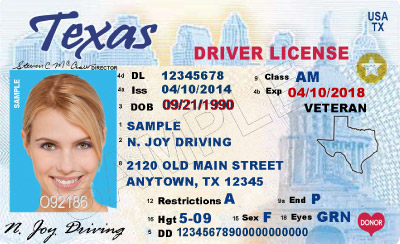Free DMV Permit Practice Test – Texas 2024 | TX

Verified by Steven Litvintchouk, M.S., Chief Educational Researcher, Member of ACES. See our detailed commitment to accuracy and quality in our practice tests.
4.39 out of 5 • 3153 votes
6 min to complete
Available in EN, ES, RU
This Texas DMV practice test has just been updated for September 2024 and covers 40 of the most essential road signs and rules questions directly from the official 2024 TX Driver Handbook. The official Texas permit test requires a passing score of 80%. As it contains 30 questions, you’ll need to answer 24 of them correctly. Texas now has a Graduated Driver License (GDL) Program, so anyone under 18 must first get a learner license, and then get a provisional license valid until they turn 18 years old. A learner license is for anyone between the ages of 15 and 18 years of age; to get one, you must pass a vision exam, the non-driving portion of a driver’s education course, and a knowledge exam, otherwise known as the permit test. You can find information about topics on the permit test, the GDL program, any license fees you’ll need to pay, and more in the Texas Driver Handbook. This DMV Practice Test will prepare you to pass the written test to get either your learner license or pass the knowledge test to get a regular license if you are over 18 years old.
What to expect on the actual exam
correct answers to pass
minimum age to apply
Helpful links
FAQs
Can I take the permit test online?
Yes, in Texas, you can take the permit test online as part of a state-approved driver education course. This option is available for teens.
How can I obtain a learner's permit?
To get a learner's permit in Texas, you must be at least 15 years old. You need to complete a driver's education course, pass a vision exam and a knowledge test, and provide the required documents for proof of identity and residency.
Can I get a license at 18 without a prior permit?
Yes, in Texas, you can apply for a driver's license at 18 without having previously held a learner's permit. However, you must pass the written, vision, and driving tests.
What documents are needed for a learner's permit?
To obtain a learner's permit in Texas, you need proof of identity, social security number, proof of Texas residency, and a Verification of Enrollment and Attendance form if you're in school.
What is the cost of a learner's permit?
The fee for a Texas learner's permit is $16.
How long is the permit valid?
In Texas, a learner's permit is valid until your 18th birthday. After that, you will need to apply for a Texas driver license.
Can I drive alone with a permit?
No, in Texas, you cannot drive alone with a learner's permit. You must be accompanied by a licensed driver who is 21 or older and has at least one year of driving experience, sitting in the front passenger seat.
More resources
Easy
- TX DMV Practice Test 1
- TX DMV Practice Test 2
- TX DMV Practice Test 3
- TX DMV Practice Test 4
- TX DMV Practice Test 5
Hard
- TX T/F Road Sign Test
- TX Signs & Situations Test
- TX Road Signs Mini
Hardest
- TX Fines & Limits Test
- TX Distracted Driving Test
- TX Drinking & Driving Test
Simulator
Are you in another state?
- Alabama: Test 1 / Test 2
- Alaska: Test 1 / Test 2
- Arizona: Test 1 / Test 2
- Arkansas: Test 1 / Test 2
- California: Test 1 / Test 2
- Colorado: Test 1 / Test 2
- Connecticut: Test 1 / Test 2
- Delaware: Test 1 / Test 2
- District of Columbia: Test 1 / Test 2
- Florida: Test 1 / Test 2
- Georgia: Test 1 / Test 2
- Hawaii: Test 1 / Test 2
- Idaho: Test 1 / Test 2
- Illinois: Test 1 / Test 2
- Indiana: Test 1 / Test 2
- Iowa: Test 1 / Test 2
- Kansas: Test 1 / Test 2
- Kentucky: Test 1 / Test 2
- Louisiana: Test 1 / Test 2
- Maine: Test 1 / Test 2
- Maryland: Test 1 / Test 2
- Massachusetts: Test 1 / Test 2
- Michigan: Test 1 / Test 2
- Minnesota: Test 1 / Test 2
- Mississippi: Test 1 / Test 2
- Missouri: Test 1 / Test 2
- Montana: Test 1 / Test 2
- Nebraska: Test 1 / Test 2
- Nevada: Test 1 / Test 2
- New Hampshire: Test 1 / Test 2
- New Jersey: Test 1 / Test 2
- New Mexico: Test 1 / Test 2
- New York: Test 1 / Test 2
- North Carolina: Test 1 / Test 2
- North Dakota: Test 1 / Test 2
- Ohio: Test 1 / Test 2
- Oklahoma: Test 1 / Test 2
- Oregon: Test 1 / Test 2
- Pennsylvania: Test 1 / Test 2
- Rhode Island: Test 1 / Test 2
- South Carolina: Test 1 / Test 2
- South Dakota: Test 1 / Test 2
- Tennessee: Test 1 / Test 2
- Texas: Test 1 / Test 2
- Utah: Test 1 / Test 2
- Vermont: Test 1 / Test 2
- Virginia: Test 1 / Test 2
- Washington: Test 1 / Test 2
- West Virginia: Test 1 / Test 2
- Wisconsin: Test 1 / Test 2
- Wyoming: Test 1 / Test 2
Your go-to, trusted source
Experience the Driving-Tests difference
Since our foundation in 2010, Driving-Tests.org has led the way in online driver's education, with over a decade of experience. Our dedicated experts, bringing together more than 50 years of collective expertise, have established us as the largest non-governmental organization in the U.S. solely focused on driver education. We go beyond the official manuals, offering unique interactive experiences and support like audio guides and an AI Assistant, to cater to different learning styles and needs.
Helping hundreds of thousands to ace their tests, our resources have earned a 4.7-star rating from over 14,500 reviews. Our goal is to make your path to becoming a confident driver as straightforward and effective as possible.
Close Created with Sketch.
Our commitment to accuracy and quality in our practice tests
Explore our rigorous, multi-tiered verification process that ensures each question mirrors the official manual for unparalleled accuracy.

Written by Andrei Zakhareuski Updated over a week ago
At Driving-Tests.org, we understand the importance of reliable and accurate practice tests to help you prepare for your DMV exam. That's why we've developed a meticulous process to create and continually update our practice questions, ensuring they reflect the most current driving laws and regulations.
Here's an inside look at how we maintain the highest quality in our practice tests.
Content Creation and Verification Process
- Alignment with Official Manuals:
Every question we develop is based on the most recent version of each state's official driving manual. Our team regularly monitors each state DMV's website for the latest updates to ensure our practice tests are always aligned with the most current information.
- Community Feedback Integration:
We leverage feedback from our vast community of users to understand which topics are most frequently tested. This helps us focus on the areas that are most relevant and beneficial for your preparation.
- Expert Content Creation:
Our in-house editor, Steven, who has extensive experience in driver education, crafts each question with precision. He conducts a thorough review of each question against the official manuals to ensure accuracy.
- Rigorous Review Process:
Once Steven has finalized a set of questions, our team conducts a joint review session. This second level of scrutiny involves content accuracy, proofreading, and fact-checking to eliminate any errors.
- User Feedback Mechanism:
After a question goes live on our site, we keep the lines of communication open. Each question features a feedback button, inviting users to report any issues or errors. This continuous feedback loop allows us to address and rectify any concerns promptly.
- Responsive Updates:
In line with our commitment to accuracy, we quickly update our practice questions to reflect any changes in the DMV manuals. Additionally, we update the free electronic copy of the state's driver's license manuals on our site, typically within a few days after the DMV publishes them.
Our thorough quality control process ensures that you have access to practice tests that are as accurate and up-to-date as possible. We believe in the power of well-prepared drivers and are dedicated to providing you with the best study tools to help you succeed on your DMV exam.
List of questions (classic view)
- If you approach a school bus from either direction while the bus is displaying alternately flashing red lights, you must
- When you approach a flashing yellow light at an intersection, you should
- _________ may be used in work zones in both day and night to guide drivers into certain traffic lanes.
- This sign indicates
- If an emergency vehicle is approaching you with its siren, bell, or flashing red lights on, you must
- In which of the following situations should you NOT drive on the left side of the road?
- In Texas, you must parallel park your vehicle within ________ of the curb or edge of the roadway.
- What does this sign indicate?
- When you're driving on the highway, you can prevent highway hypnosis by
- When you approach a railroad crossing that a train is approaching, you must stop your vehicle _________ from the nearest rail.
- If your vehicle is equipped with airbags, you should use _________ to turn the steering wheel in most driving situations.
- What does this sign mean?
- If a tire blows out, you should
- In a roundabout, you must drive
- At night, you should dim your headlights to low beam whenever you are
- What does this sign mean?
- If a broken yellow line is on your side of the centerline,
- If you are driving faster than the other traffic on a freeway, you should use
- Areas of the road that you cannot see in your mirrors are called
- What does this sign mean?
- For drivers who are at least 21 years of age, the legal limit for blood alcohol concentration (BAC) is
- The stopping distance of an average passenger car traveling at 55 mph is approximately
- In Texas, the speed limit in urban districts is _______ unless otherwise posted.
- What does this sign indicate?
- When a vehicle's tires lose contact with the roadway and rise up on top of the water, the condition is called
- In Texas, which occupants of a passenger vehicle must wear safety belts or appropriate child restraints?
- A pennant-shaped sign indicates
- What does this sign mean?
- When going down a steep hill, you should
- At speeds over 30 mph, you should maintain a following distance of at least ________ behind the vehicle ahead of you.
- In Texas, you must use your headlights from one half hour after sunset until
- What does this sign mean?
- __________ on your side of the road indicates a no-passing zone.
- When approaching an intersection where there are no signs or traffic lights, you must
- Under Texas law, if you intend to turn, you must signal continuously for at least _________ before you turn.
- This sign indicates
- If you're driving at night in fog or heavy rain, use
- Under Texas law, you must not park your vehicle
- To avoid the glare of an oncoming vehicle's headlights, you should shift your eyes
- This sign means that



